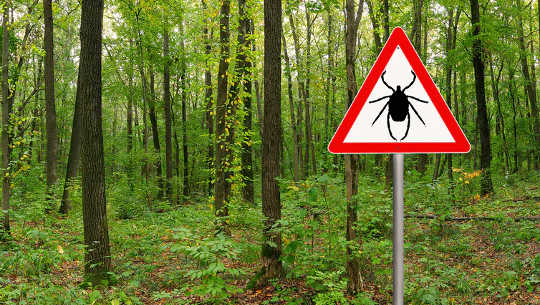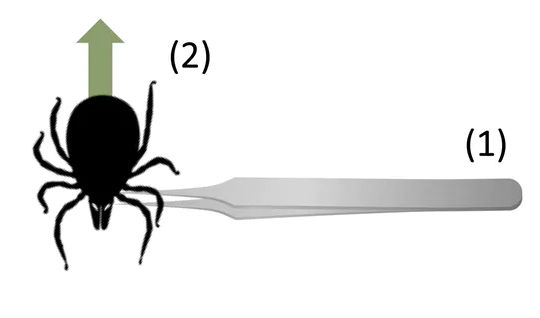
With warm weather comes tick season. (Shutterstock)
Blooming flowers, chirping birds and long-awaited rays of sunshine: The first signs of spring are often greeted with joy. But soon comes the realization that with warm weather comes ticks.
With the climate warming, diseases caused by ticks are predicted to spread further into Canada. Infected ticks are transported by different host species that are expanding their ranges northward. For example, white-footed mice, a major tick host, are shifting their ranges northward up to 15 kilometres per year.
For researchers like me who study ticks, the spring represents the start of fieldwork. We visit different locations in search of our bloodsucking friends. It also provides us with an opportunity to talk about ticks with people who are enjoying the outdoors.

Common tick species in Canada. From left to right: blacklegged tick (Ixodes scapularis), bird tick (Ixodes auritulus), rabbit tick (Haemaphysalis leporispalustris) and dog tick (Dermacentor variabilis).
Get The Latest By Email
Through these interactions, I began to realize how much anxiety is caused by the increased presence of ticks in Canada and by the myths about ticks that have come with them. Here are some of the most common myths about ticks that I would like to debunk:
Myth: Ticks are only seasonally active in forests
Many people think that ticks can only survive in forests from the spring to fall, but this is no longer true.
With the expanding ranges of their hosts, ticks are appearing in greater numbers close to city centres like Toronto and Montréal. Ticks are even being found in people’s backyards due to the annual reproduction of nearby populations. Unfortunately, some of these ticks have also tested positive for Borrelia burgdorferi, the bacteria that cause Lyme disease.
Myth: Ticks can jump
How do ticks find their way onto people? Many people described having ticks jumping on them from trees, but ticks can’t jump. Instead, they patiently sit on low vegetation or crawl around the ground, sensing a host’s carbon dioxide and heat.
Ticks search for their next meal when temperatures are above 4°C. During the winter, people think that ticks are inactive or dead because of the cold. However, if temperatures rise above freezing for several days, ticks can emerge from their dormancy, leaving us and our pets at risk.
Myths about how to remove ticks
Fact: Painless ticks need to be removed with tweezers.
Last summer, I was doing a tick check after being outdoors. I inspected every part of my body for ticks especially in crevices and anywhere covered by hair and, to my horror, I found a tick. I was shocked that I hadn’t felt its bite, but you likely won’t feel it either.
Ticks have developed a critical tool to discreetly attach to their host: their saliva. We don’t react to their bites because ticks make sure we don’t know they’re there. Their saliva contains multiple components that trick our bodies into blocking pain and itching, as well as stopping any defensive immune responses.
When a tick is attached, it should be removed quickly. I’ve heard of many removal methods including lit matches, different household items (for example, essential oils, petroleum jelly, soap or rubbing alcohol), or squeezing with your fingers. You are more likely to contract a disease using these methods because a tick can regurgitate its content — like bacteria and viruses — into you before dying.
 How to properly remove an attached tick. First, locate the head of the tick close to the skin with fine-tipped tweezers. Then, pull the tick straight upward with even force. Pixabay
How to properly remove an attached tick. First, locate the head of the tick close to the skin with fine-tipped tweezers. Then, pull the tick straight upward with even force. Pixabay
Fine-tipped tweezers are the only efficient and safe way to remove a tick. Use the tweezers to grab the head close to the skin and lift straight upwards with steady even pressure. Parts of the tick’s head or mouth may remain, but they are unable to transmit any disease without the body.
Myth: All ticks are infected with Lyme disease
People often panic thinking they will immediately get infected with Lyme disease if they’re bitten by a tick. In Canada, some ticks may not be infected at all, while others can carry a variety of less prevalent diseases besides Lyme disease, which is the most common.
For example, blacklegged ticks can also transmit babesiosis and Powassan virus. Dog ticks are well-known carriers of Rocky Mountain spotted fever and tularemia. Both kinds of ticks can also pass on anaplasmosis and ehrlichiosis.
If a tick is infected, the time it takes for a disease to be transmitted varies. Usually Lyme disease requires more than 24 hours for transmission, but studies have shown that this could happen in less than 16 hours. Some diseases like Powassan virus are transmitted very quickly, in less than 15 minutes.
Lyme disease is well known for its bullseye rash, but this symptom might only be present in 70 to 80 per cent of infected people. Other variations of the rash can include blistering, uniform or crusted skin lesions or a blue-purple colour. As the bacteria spread through the blood, these rashes may appear in other areas of the body far from the bite site.
Rather than relying on the presence of a rash, the most accurate way to detect disease is to check for several early symptoms after a tick bite. Symptoms like fever, joint pain, muscle aches, fatigue and headaches usually start to appear in three to 30 days.
Prevention, and when to see a doctor
If a tick has been attached for more than 24 hours, a visit to the doctor is recommended, especially in high-risk regions for Lyme disease. People treated with the appropriate antibiotics as either a preventive measure or with the onset of disease symptoms usually recover rapidly and completely.
Tick bites might be worrisome, but need not cause panic. Prevention remains the best protection against ticks. Insect repellents like DEET or Natrapel, long-sleeved shirts and pants and full-body tick checks on ourselves and our pets can help prevent tick exposure while still letting us to enjoy the outdoors.
About the Author
Kirsten Crandall, Ph.D. Cotutelle candidate, Department of Biology, McGill University
books_pets
This article is republished from The Conversation under a Creative Commons license. Read the original article.







